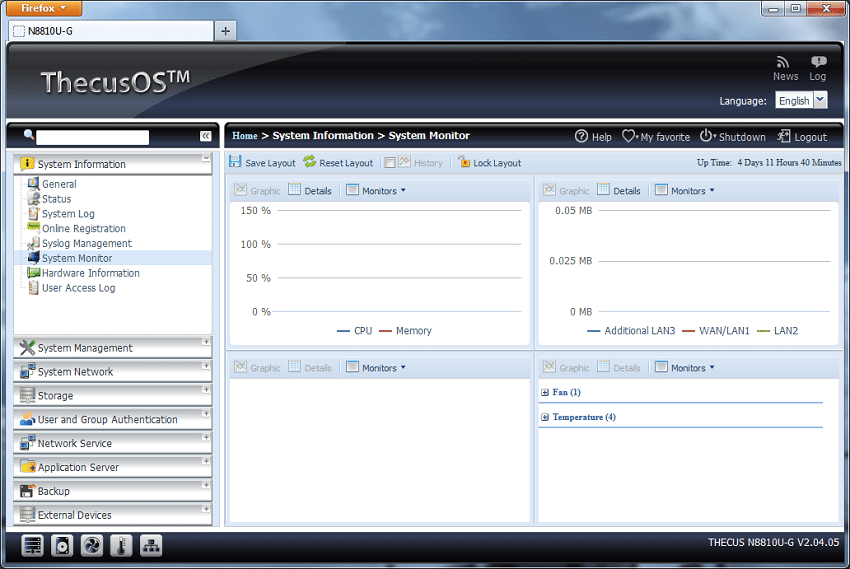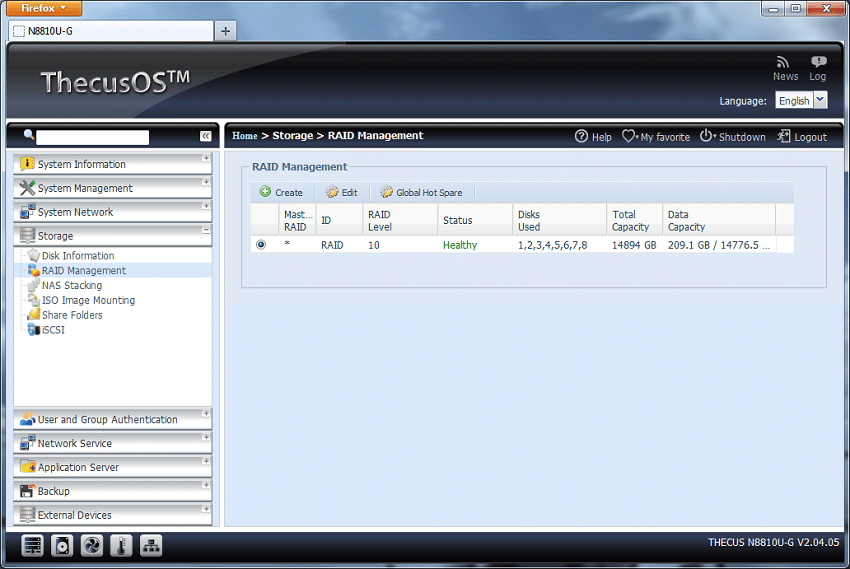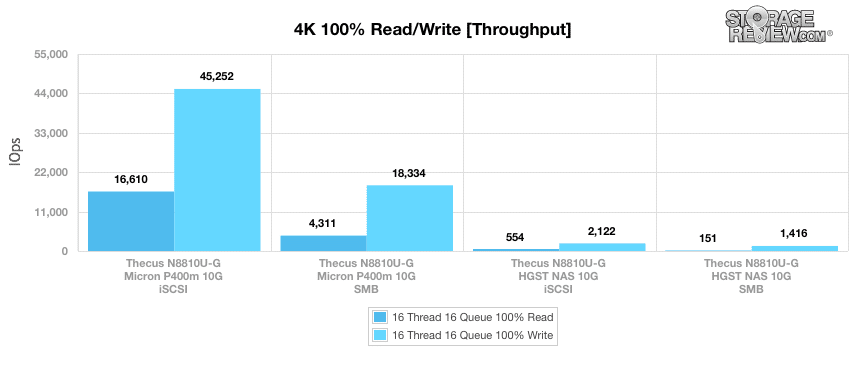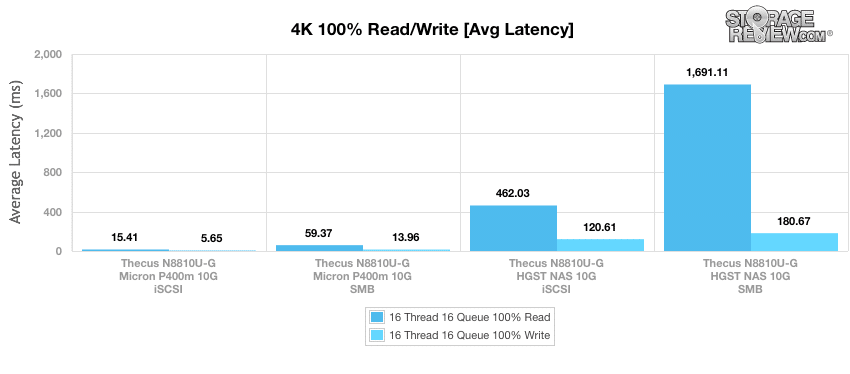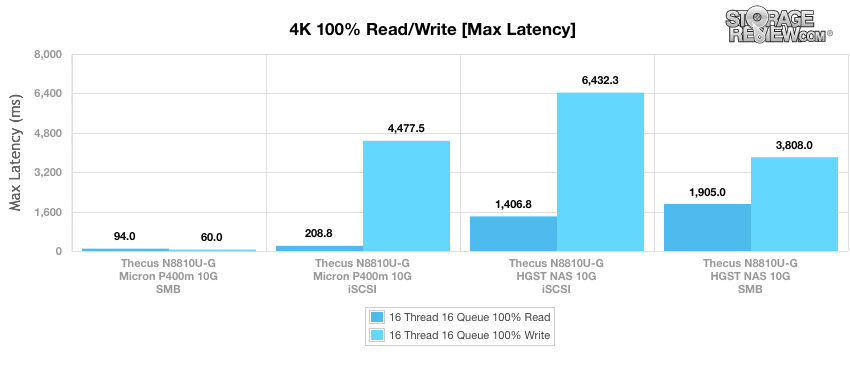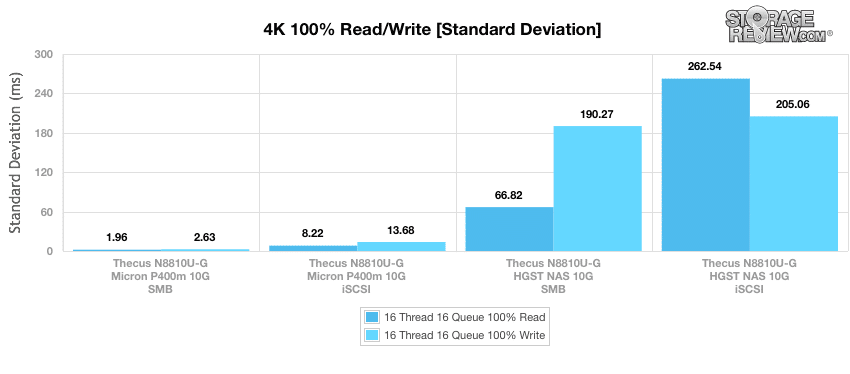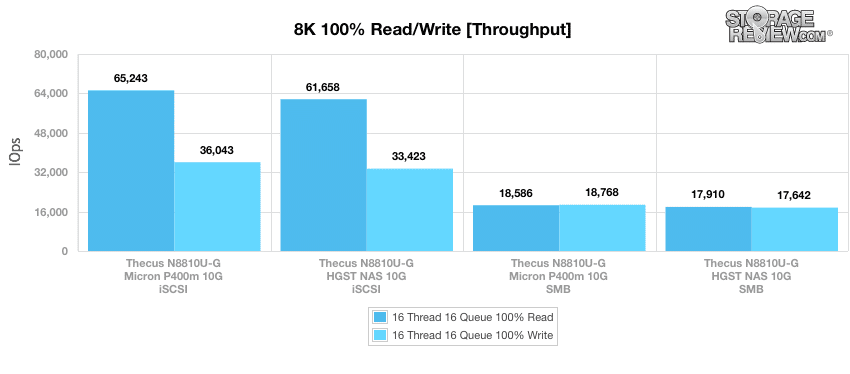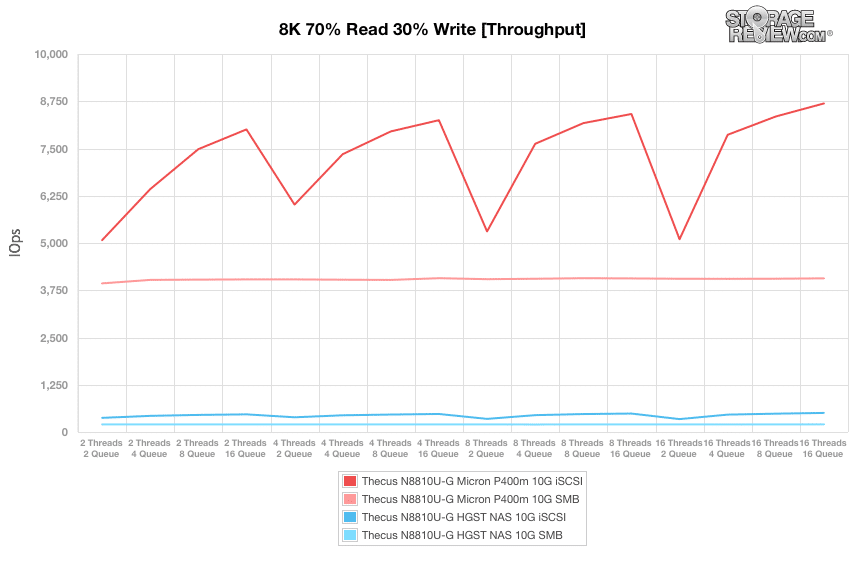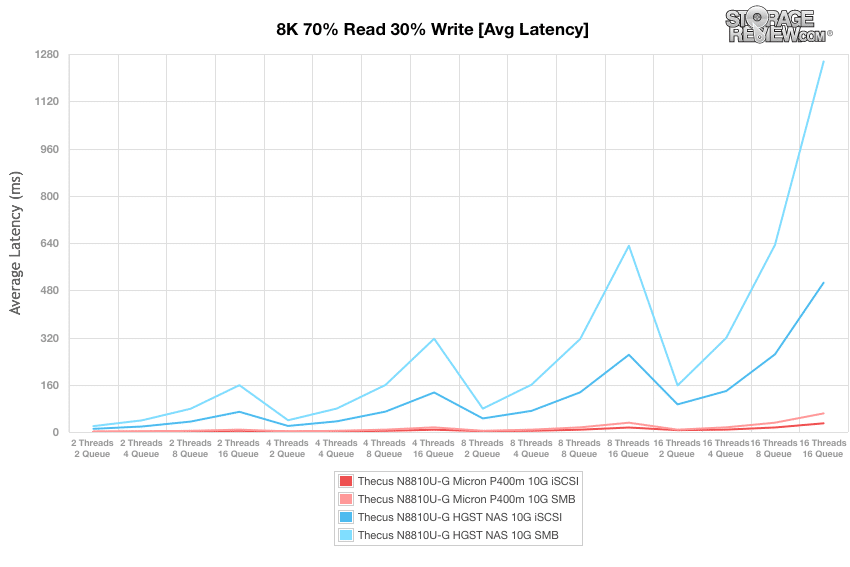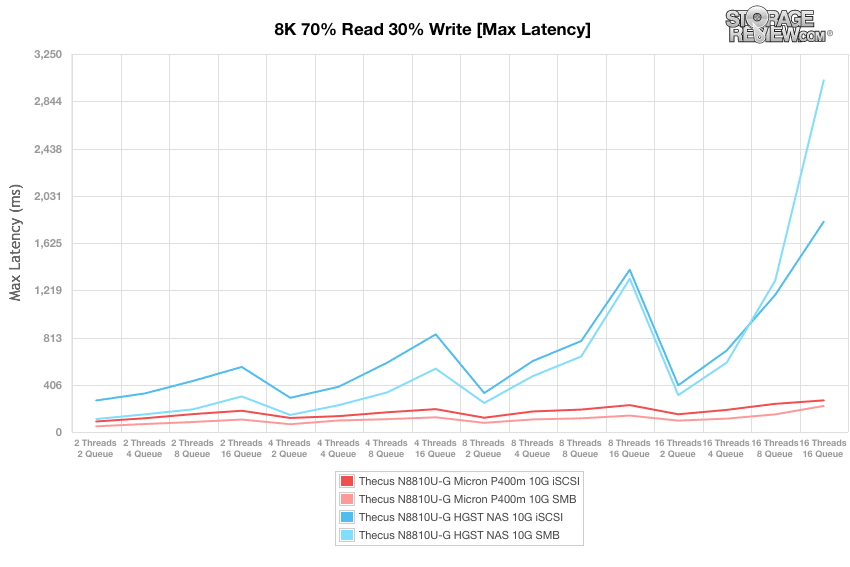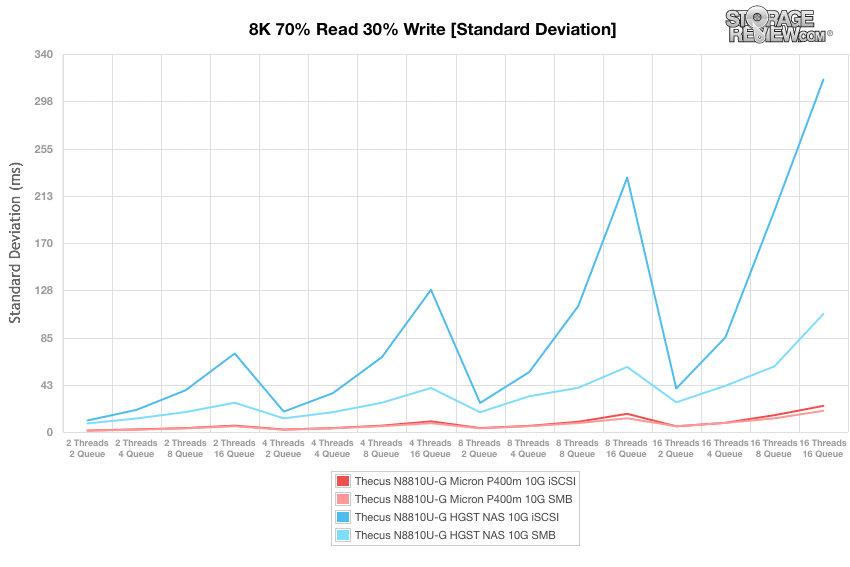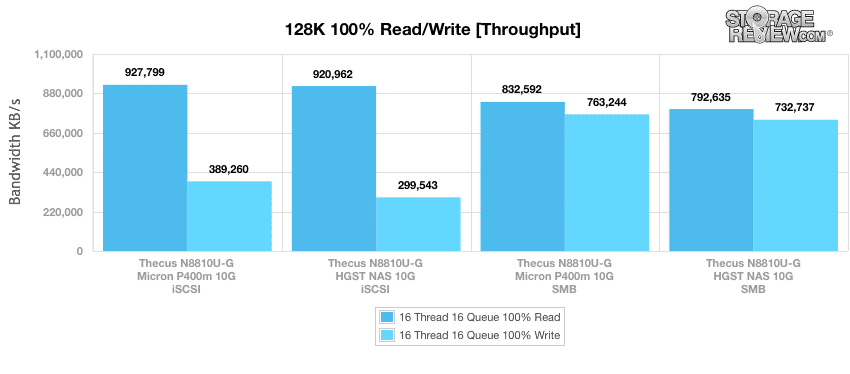
The Thecus N8810U0-G is an 8-bay NAS that uses an Intel Pentium 2.9GHz dual core processor and 4GB RAM to provide up to 48TB of raw storage capacity. The N8810U0-G includes an array of features making it an interesting contender in the small office/home NAS market thanks to a mix of business and home user features. These range from the inclusion of 10GbE, VMware Ready certification and iSCSI thin-provisioning to iOS/Android apps and HDMI out.

Other highlights of the NAS include volume safety through the N8810U0-G’s volume encryption feature (which allows users to fully encrypt RAID volumes), Data Guard (allows users to back up data across RAID volumes, through USB drives, eSATA, and other NAS consoles and servers through a user-friendly interface), cloud backup (users can choose from DropBox, Amazon S3, or ElephantDrive), Acronis True Image backup, Data Burn (physical backup to CD, DVD, and Blu-ray discs), Link Aggregation (connecting the console to multiple network connections to protect against a potential disconnect), Rsync, and McAfee Antivirus.
The Thecus N8810U0-G carries a 2-year warranty and a $2,000 price tag.
Specifications
- CPU: Intel Pentium 2.9GHz Dual Core
- System Memory: 4GB DDR3 ECC
- Drive Bays: 8, 3.5-inch or 2.5-inch
- Max. Drive Bays: 8
- Max. Internal Capacity: 48TB
- USB 2.0 Ports: 6
- USB 3.0 Ports: 2
- HDMI Output: 1
- VGA Output: 1
- Supported RAID Types: JBOD and RAID 0, 1, 5, 6, 10, 50, 60
- Power Recovery
- Scheduled Power On/Off
- System Fan: x4 hot swappable
- Size (HxWxD): 90 x 428 x 586 mm
- Weight: 23.29 kg
- Warranty: 2 Years
Design and Build
The front of the console presents the eight lockable drive bays in a 3x2x3 setup (above the two centered drive bays sits a status screen). To the far left of the front there are two USB 2.0 ports, a mute button, fan status light, reset button, power status light, and power button. Each drive tray has two LED status lights.
The rear of the console exposes four fans (with two corresponding power switches), two AC power ports, two Gb Ethernet ports, one 10Gb Ethernet ports, two USB 3.0 ports, four USB 2.0 ports, once VGA port, and one HDMI port.
Management
Thecus OS is somewhat of a cross between Synology’s DiskStation and FreeNAS in terms of appearance and usability. Volume creation isn’t as intuitive as it could be and it can take quite some time finish (it took us a few minutes but can take a few hours), and encryption must be included at this stage rather than during folder creation. However, once the volume is created it is very easy to add folders.
The status of the N8810U-G NAS console and network can be easily checked via a management bar at the bottom-right of the interface. Users can check the temperature, fan status, manage RAID, and check disk info.
Testing Background and Comparables
We tested both SMB and iSCSI performance using RAID10 configurations of the Micron P400m 200GB SSD as well as the HGST NAS 4TB HDD.
Volume configurations tested for this review:
- Micron P400m 200GB
- RAID10 SMB (Four 25GB test files presented through four shared folders)
- RAID10 iSCSI (Four 25GB Instant Allocated iSCSI LUNs presented through 4 iSCSI targets)
- HGST NAS 4TB (7,200RPM)
- RAID10 SMB (Four 25GB test files presented through four shared folders)
- RAID10 iSCSI (Four 25GB Instant Allocated iSCSI LUNs presented through 4 iSCSI targets)
Network configuration leveraged for this review:
- Thecus N8810U-G
- (1) IP address assigned through single 10G interface used for all four SMB or iSCSI shares
- Windows Server 2012 LoadGen VM
- (1) IP address assigned through dedicated vSwitch mapped to Emulex OCe11102-NT port
The StorageReview Enterprise Test Lab allows us to provide relevant and unbiased benchmarks of enterprise storage devices by establishing a testing environment comparable to what IT administrators encounter in real datacenter and field deployments. The Enterprise Test Lab incorporates a variety of servers, networking, power conditioning, and other infrastructure to design real-world configurations that accurately reflect the performance of storage devices during reviews.
We incorporate details about our lab environment and testing protocols into the review so that administrators and those responsible for equipment acquisition can fairly gauge the conditions under which we have achieved these published results. None of our reviews are paid for or controlled by the manufacturer of equipment we are testing. Additional details about the StorageReview Enterprise Test Lab and an overview of its networking capabilities are available on those respective pages.
In order to fairly evaluate the performance of the Thecus N8810U-G we need an environment that ensures that it is the I/O bottleneck rather than the network. Therefore this review employs a Lenovo ThinkServer RD240 running multiple Windows Server 2012 VMs in an ESXi 5.1 environment connected via a dual-port Emulex OCe11102-NT 10GBase-T NIC through a Netgear ProSafe XS712T 10G switch.
- 2 x Intel Xeon X5650 (2.66GHz, 12MB Cache)
- Windows Server 2008 Standard Edition R2 SP1 64-Bit running on VMware ESXi 5.1
- Intel 5500+ ICH10R Chipset
- Memory – 32GB (4 x 8GB) 1333Mhz DDR3 Registered RDIMMs
Netgear ProSafe XS712T 10G Switch
- 12 10GBase-T RJ45 Ports, 2 10GbE SFP+ Uplink Ports
- 240Gbps Aggregate Bandwidth
Enterprise Synthetic Workload Analysis
Prior to initiating each of the fio synthetic benchmarks, our lab preconditions the device into steady-state under a heavy load of 16 threads with an outstanding queue of 16 per thread. Then the storage is tested in set intervals with multiple thread/queue depth profiles to show performance under light and heavy usage.
Preconditioning and Primary Steady-State Tests:
- Throughput (Read+Write IOPS Aggregate)
- Average Latency (Read+Write Latency Averaged Together)
- Max Latency (Peak Read or Write Latency)
- Latency Standard Deviation (Read+Write Standard Deviation Averaged Together)
The synthetic analysis incorporates four profiles, including 4k and 8k 70/30 benchmarks which are widely used in manufacturer specifications and benchmarks.
- 4k
- 100% Read and 100% Write
- 8k
- 100% Read and 100% Write
- 70% Read/30% Write
- 128k
- 100% Read and 100% Write
Our first benchmark gauges the performance of random 4k transfers comprised of 100% write and 100% read activity. The Micron P400m drives outclassed the HGST NAS drives in both read and write, and the iSCSI configuration of the Micron P400m outclassed the SMB configuration, achieving more than 45,000 and 16,000 IOPS in write and read, respectively. The iSCSI configuration of the HGST NAS drive slightly outperformed its SMB configuration.
Consistent with the results of the 4K throughput test, in the average latency measurement the Micron P400m drives outclassed the HGST NAS drives in both configurations and in both read and write. The fastest performer in write functions was the Micron P400m drive in the iSCSI configuration with 5.65 ms (it was also the fastest read performer with 15.4 ms). The slowest performer in this test was the SMB configuration of the HGST NAS drive, with 1691 and 180.7 ms in read and write, respectively.
In terms of maximum latency, the write performance of the iSCSI configuration of the Micron P400m (4478 ms) was not up to par with its performances in previous tests. It was outpaced by both the SMB configuration of the Micron P400m drive (60.6 ms) and the SMB configuration of the HGST NAS drive (3808 ms). The fastest read performance was accomplished by the SMB configuration of the Micron P400m (94 ms).
The SMB configuration of the Micron P400m drive achieved the lowest standard deviation out of all other drives and configurations tested, in both read and write functions (1.96 and 2.63 ms, respectively). A close second was the iSCSI configuration of the Micron P400m drive (8.23 and 13.7 ms, respectively). Both configurations of the HGST NAS drive performed relatively poorly.
Our next benchmark measures 100% 8K sequential throughput with a 16T/16Q load in 100% read and 100% write operations. The SMB configurations performed similarly in both drives, as did the iSCSI configurations. Overall, the top performer was the iSCSI configuration of the Micron P400m drive (65,240 and 36,000 IOPS for read and write, respectively) and the worst performer was the SMB configuration of the HGST NAS drive (17,900 and 17,600 IOPS for read and write, respectively).
Compared to the fixed 16 thread, 16 queue max workload we performed in the 100% 4k and 8k write tests, our mixed workload profiles scale the performance across a wide range of thread/queue combinations. In these tests, we span workload intensity from 2 threads and 2 queue up to 16 threads and 16 queue. The iSCSI configuration of the Micron P400m was the top performer in the throughput portion of this benchmark, although its performance was not very stable. The next best performer was the SMB configuration of the Micron P400m drive, and the worst performer was the SMB configuration of the HGST NAS drive.
Both configurations of the Micron P400m achieved very low average latencies and were consistent through the duration of the test (the iSCSI configuration slightly outpaced the SMB configuration). Both configurations of the HGST NAS drives showed sporadic performances that were slower than the Micron P400m drives, but the SMB configuration of the HGST NAS drive was the overall slowest performer.
We found similar results in the maximum latency measurement; the Micron P400m drives performed faster and more consistently. However, the SMB configuration of the Micron P400m was the fastest drive in this test, and for all but the very end of the test, the iSCSI configuration of the HGST NAS was the slowest performer.
For most of the standard deviation test, the iSCSI and SMB configurations of the Micron P400m drive performed similarly, with the SMB configuration edging out iSCSI at the very end. The iSCSI configuration of the HGST NAS was the least consistent performer for this benchmark.
The last test in our Enterprise Synthetic Workload testing is the 128k test, which is a large block sequential test that shows the highest sequential transfer speed for a platter drive. Although both configurations of both drives performed similarly in read functions, the top performer was the iSCSI configuration of the Micron P400m, with 930,000 KB/s. The top performer in write functions was the SMB configuration of the Micron P400m (763,000 KB/s), and the worst was the iSCSI configuration of the HGST NAS (300,000 KB/s).
Conclusion
The Thecus N8810U-G, which is capable of storing up to 48TB of storage with 6TB disks, can leverage 10GbE connectivity and features a slurry of security features including Data Guard, cloud backup, Data Burn, and McAfee antivirus. It has a 2U horizontal design with a 3x2x3 drive layout, which looks fine, but isn’t as dense as other 2U NAS that support up to 12 drives in the same footprint. From a usability standpoint, the Thecus management tools are effective, but lack the visual polish QNAP, Synology and others bring to the table.
From a performance perspective, the Micron P400m SSDs in iSCSI configuration performed best, although the SMB configuration performed well in the 4K average latency and 128K throughput measurements. For more modest use cases we also tested HGST’s NAS drives which still offered excellent sequential performance leveraging the N8810U-G’s 10G interface. In terms of random I/O, the SSDs performed quite well, although random 4K write performance with the HDDs was lacking compared to some tower-style NAS systems such as the Synology DS1813+ leveraging just 1GbE. For users needing to move lots of multimedia content around in a smaller environment this type of system would work quite well. In a multi-user environment leveraging either iSCSI or SMB, units like the DiskStation DS1813+ or QNAP TS-470 offer double the mixed workload performance with the same amount or half the SSDs respectively.
Pros
- Lots of features (mostly security)
- 10GbE Included
Cons
- Lacks density in 2U form factor
- Interface is dated with initial setup being more cumbersome than most others
- Poor mixed workload performance
The Bottom Line
The Thecus N8810U0-G offers 8 bays of 10GbE NAS functionality that’s flexible enough to be used in both small workgroups and home environments with a media serving focus but doesn’t find a way to stand out in the crowded NAS space.



